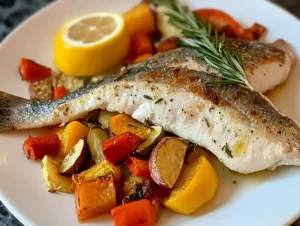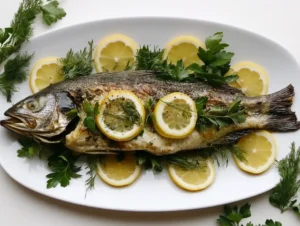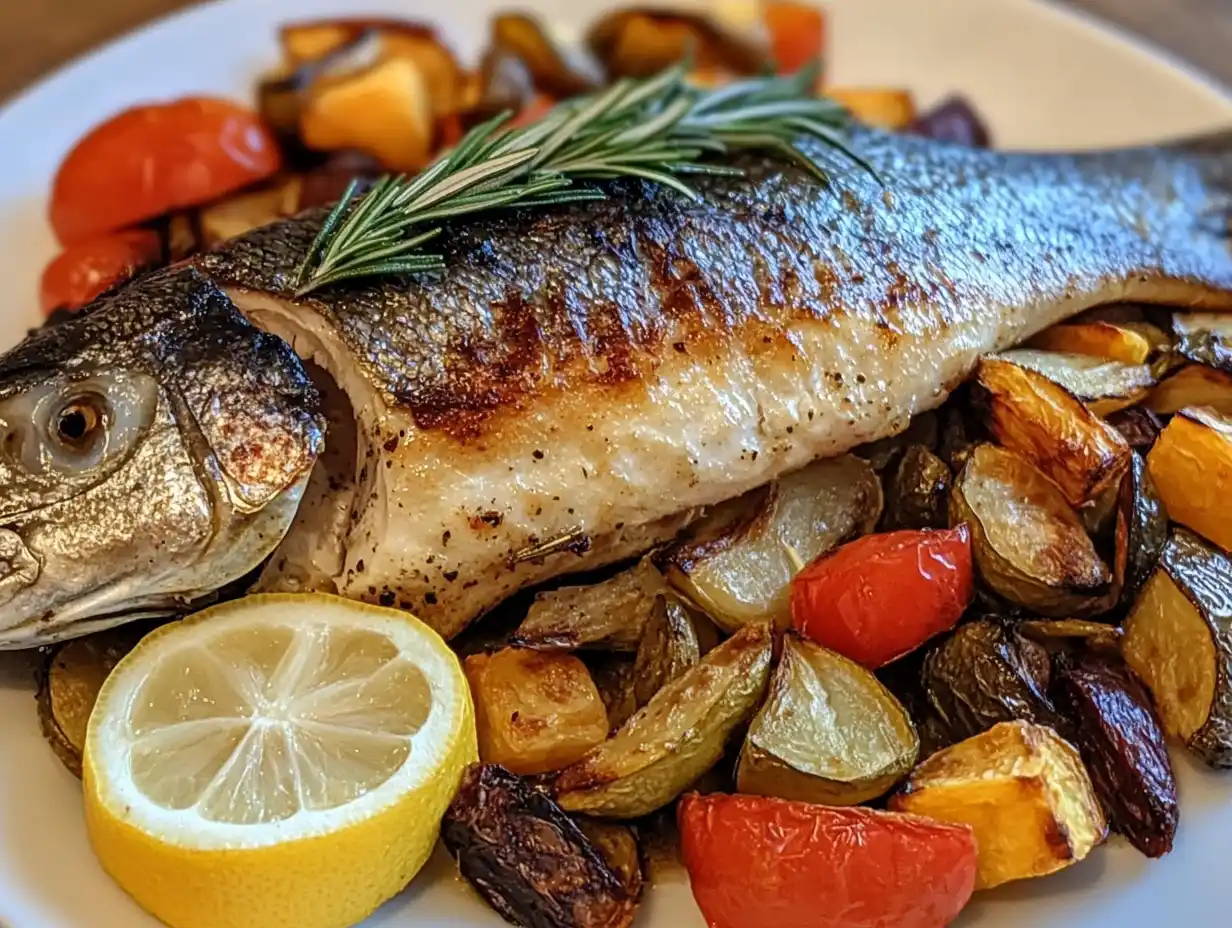Bronzini, also called European sea bass, is one of the most popular fish in Mediterranean cuisine. Renowned for its mild flavor, delicate texture, and incredible versatility in recipes, it has found its way onto plates worldwide. But what exactly makes this fish so special? Where does it come from, and how can you enjoy it? This article dives deep into the world of bronzini, covering everything from its habitat and characteristics to its culinary uses, market insights, and sustainability. Let’s explore what makes this fish a favorite among seafood lovers! 🐟✨
Overview of Bronzini
Bronzini, with its unique name and reputation, is far more than just another fish. Let’s uncover its identity, origins, and why it’s a star in the culinary world.
What is Bronzini?
Bronzini (Dicentrarchus labrax), often referred to as European sea bass, is a mild white fish that thrives in the waters of the Mediterranean, as well as along the coasts of Europe and North Africa. Known for its soft, flaky texture and clean, slightly sweet flavor, it’s a go-to choice for chefs looking to highlight the natural taste of seafood without overpowering spices. The fish is often prepared whole, grilled, or roasted, making it a centerpiece of many Mediterranean-inspired meals.
Many might wonder, “What kind of fish is bronzini?” The answer is simple: it’s a versatile, crowd-pleasing fish loved for its flavor and ease of preparation. Its popularity has soared beyond Europe and into restaurants and kitchens worldwide. 🌍
Bronzini vs. Other Sea Bass Varieties
Although bronzini is often grouped with other sea bass varieties, it has some distinct characteristics. Unlike its cousins like black sea bass or striped bass, bronzini is smaller, with a more tender texture. Its skin is thin and crisps beautifully when grilled, while its subtle flavor pairs perfectly with citrus, herbs, and olive oil.
Another fun fact? The name bronzini is typically used in Italian and Mediterranean culinary contexts, while in English-speaking countries, it’s often referred to as branzino. Same fish, just a different name!
Origin of the Name “Bronzini”
The term bronzini comes from Italian roots, where the fish is celebrated as a delicacy. In fact, the name pays homage to the Mediterranean region, where this fish has been a dietary staple for centuries. With its culinary versatility and cultural significance, it’s no surprise this fish has gained international fame.
🥗 Fun tidbit: In Italy, you’ll often see bronzini served whole with fresh lemon wedges, herbs, and a drizzle of olive oil. Simple yet spectacular!
Bronzini’s Habitat and Characteristics
Where Bronzini Lives: Native Regions and Migration Patterns
Bronzini (*European sea bass*) calls the coastal waters of the Mediterranean Sea and the eastern Atlantic Ocean its home. These fish often inhabit shallow waters, particularly around estuaries, lagoons, and near rocky shores. In the warmer months, they move closer to shore, making them easier to catch, while in colder months, they migrate to deeper waters for safety and warmth.
The adaptability of bronzini to both saltwater and brackish environments is one of the reasons it has become so widespread in aquaculture farms. This dual habitat adaptability ensures the fish is available year-round, satisfying the growing global demand.
Physical Description of Bronzini
Ever wondered, *“What kind of fish is bronzini?”* It’s easy to identify this fish by its sleek, silver-gray body with darker tones along its back. Typically, bronzini grows to about 1–2 feet long and weighs around 1–3 pounds, making it perfect for serving whole. Its thin, edible skin adds to its appeal in culinary circles, especially when crisped during roasting or grilling.
Bronzini’s large, round eyes and forked tail are evolutionary traits that help it hunt prey like small fish, crustaceans, and mollusks in its natural habitat. Its streamlined body also makes it an excellent swimmer, capable of quick movements to avoid predators.
Life Cycle and Feeding Habits
Bronzini is a hardy fish that reaches maturity between 2–4 years. Spawning typically occurs in winter when the fish release eggs in coastal waters, which later hatch into larvae. These juvenile fish then make their way to estuaries and shallow habitats to grow and feed.
As opportunistic feeders, bronzini consume a mix of small fish, shrimp, and other aquatic life, contributing to their mild yet flavorful taste. This varied diet is also why farm-raised bronzini is often carefully fed to replicate their natural eating patterns for optimal taste and nutrition.
🐠 **Did you know?** Bronzini’s ability to thrive in both wild and farmed settings has made it one of the most sustainable fish on the market!

Culinary Uses of Bronzini
If you’ve ever been to a Mediterranean restaurant, chances are you’ve seen *bronzini* on the menu. Let’s explore why this fish is a chef’s favorite! 🥂✨
Bronzini in Mediterranean Cuisine
In Mediterranean cuisine, bronzini is a true star. In Italy, it’s often referred to as *branzino*, while in Greece, it goes by *lavraki*. This fish has been a staple in traditional recipes for centuries, celebrated for its mild, versatile flavor.
Classic dishes include whole-roasted bronzini with lemon and herbs, grilled bronzini served alongside a light salad, or even poached bronzini in tomato-based stews. Its subtle sweetness pairs beautifully with Mediterranean staples like olive oil, capers, and garlic.
Looking for some culinary inspiration? Check out [this recipe for grilled seafood dishes](https://delightedrecipes.com/what-you-need-to-know-about-branzini-and-branzino/) to bring the flavors of the Mediterranean into your kitchen.
Popular Ways to Prepare and Cook Bronzini
One of the reasons bronzini is so beloved is because it’s incredibly easy to cook. Whether you’re a seasoned chef or a beginner in the kitchen, bronzini can elevate your cooking game.
– Grilling: Perfect for summer barbecues, whole bronzini grills beautifully over open flames. A drizzle of olive oil and a squeeze of lemon are all you need.
– Roasting: When roasted whole, bronzini develops a crispy skin while retaining its moist, flaky flesh. It’s often stuffed with herbs like rosemary and thyme for added flavor.
– Pan-Seared: For a quick and flavorful dinner, fillets of bronzini seared in butter and garlic are hard to beat.
For more preparation ideas, check out [this seafood sauce guide https://delightedrecipes.com/ultimate-sauce-for-shrimp/), which can easily complement bronzini dishes.
Nutritional Profile: Is Bronzini a Healthy Choice?
If you’re wondering, *“Is bronzino a good fish to eat?”* the answer is a resounding yes! This fish is rich in omega-3 fatty acids, which are essential for heart and brain health. A 3.5-ounce serving of bronzini provides a good dose of protein, vitamins D and B12, and selenium, all while being low in calories.
Because of its lean protein and healthy fat content, bronzini is often recommended for people following Mediterranean or heart-healthy diets. It’s also a great option for those looking to cut back on red meat without sacrificing flavor or nutrients.
🍋 **Pro tip:** Pair bronzini with a side of yellow rice or a refreshing citrus salad for a well-rounded, nutrient-packed meal!
Bronzini vs. Similar Fish
Ever wondered how bronzini stacks up against other fish? Let’s compare its taste, texture, and unique qualities to similar species. 🐟✨
What Fish is Similar to Bronzini?
When answering the question “What kind of fish is bronzini?” it’s natural to draw comparisons. Bronzini shares similarities with other white fish, such as black sea bass, striped bass, and red snapper. These species all have mild flavors and flaky textures, making them great substitutes in recipes.
However, bronzini stands out for its slightly sweet, delicate flavor, which is less robust than black sea bass and less oily than striped bass. Its versatility in Mediterranean recipes makes it a favorite for grilling, roasting, or poaching.
Comparing Bronzini with Black Sea Bass and Striped Bass
While bronzini and black sea bass are often grouped together, there are some key differences:
- Flavor: Bronzini’s sweetness sets it apart from the slightly richer taste of black sea bass.
- Texture: Both have tender, flaky flesh, but bronzini’s thinner skin crisps more easily when roasted or grilled.
- Size: Black sea bass tends to be smaller, making bronzini more suitable for larger servings or whole fish presentations.
On the other hand, striped bass has a firmer texture and a bolder taste compared to bronzini. For those who prefer a more subtle seafood flavor, bronzini is often the better choice.
Why Bronzini is Unique Among White Fish
Bronzini’s uniqueness lies in its adaptability. It can be prepared with minimal seasoning or paired with bold Mediterranean flavors, making it a go-to for home cooks and professional chefs alike. Its skin, when properly cooked, adds a layer of crunch that’s hard to resist.
For more tips on preparing bronzini, you might enjoy this guide on shrimp sauces that work equally well with mild white fish.
Market Insights: Buying and Pricing Bronzini
Ready to bring bronzini into your kitchen? Here’s how to select the best fish and what to expect in terms of pricing. 🛒🐠
Is Bronzini an Expensive Fish?
One of the most common questions about bronzini is whether it’s an affordable option. While it’s pricier than some fish like tilapia or catfish, bronzini is generally considered a mid-range option. The price can vary depending on whether it’s wild-caught or farmed, as well as its origin.
Farmed bronzini, which makes up a large portion of what’s available in stores, is often more budget-friendly than wild-caught varieties. Expect to pay between $10–$15 per pound for whole farmed bronzini, while wild-caught options may cost closer to $20–$25 per pound.
How to Select Fresh Bronzini at Markets
When shopping for bronzini, freshness is key. Look for these signs to ensure you’re getting the best quality:
- Clear, bright eyes: Cloudy eyes can indicate the fish is no longer fresh.
- Firm flesh: Gently press the fish; it should bounce back rather than leaving an indentation.
- Shiny skin: The scales should look smooth and moist, not dull or dry.
- A clean, briny smell: Fresh bronzini should smell like the ocean, not fishy.
For more details on selecting the freshest seafood, you might enjoy exploring this guide on preparing shrimp for recipes.
Frozen vs. Fresh Bronzini: What to Know
While fresh bronzini is preferred for its texture and flavor, frozen options are an excellent alternative, especially when wild-caught isn’t in season. When buying frozen, check for vacuum-sealed packaging to prevent freezer burn.
Environmental Impact and Sustainability
With rising demand for seafood, sustainability is more important than ever. Let’s explore how bronzini fits into this picture. 🌍🐟
Farming Bronzini: The Rise of Aquaculture
As bronzini grows in popularity, aquaculture—or fish farming—has become the primary way to meet demand. This controlled farming environment helps reduce overfishing in the wild, making bronzini a more sustainable choice compared to other seafood.
Farmed bronzini are typically raised in Mediterranean regions using sustainable practices that minimize environmental harm. Many farms focus on maintaining clean water conditions and feeding the fish a balanced diet to replicate their natural habitat.
Wild vs. Farmed Bronzini: Environmental Considerations
While wild-caught bronzini boasts a richer flavor, its environmental impact can sometimes be higher. Overfishing and bycatch are concerns with wild harvesting, which is why sustainably farmed bronzini is often the better choice for eco-conscious consumers.
Fortunately, many retailers label their bronzini with certifications like MSC (Marine Stewardship Council) or ASC (Aquaculture Stewardship Council), so you can make informed decisions.
Sustainability Certifications for Bronzini
If you’re wondering, “What kind of fish is bronzini?” it’s not just a tasty choice but also a responsible one—when sourced correctly. Look for certification labels on packaging, and always ask your fishmonger about the origin of the fish.
By choosing sustainable bronzini, you’re supporting eco-friendly seafood practices while enjoying one of the Mediterranean’s finest delicacies.

Frequently Asked Questions
Let’s tackle some of the most common questions about bronzini to clear up any doubts. 🐟❓
Is Bronzino a Good Fish to Eat?
Absolutely! Bronzino (or bronzini) is a top choice for its mild flavor, versatility, and health benefits. It’s low in calories, rich in omega-3 fatty acids, and packed with nutrients like selenium and vitamin B12. Plus, it pairs well with various seasonings and side dishes, making it a great addition to your diet.
Is Bronzino and Bronzini the Same Fish?
Yes, they’re the same! The term bronzini is Italian, while bronzino is commonly used in English-speaking countries. Both names refer to European sea bass (Dicentrarchus labrax).
What Fish is Similar to Bronzini?
If you’re looking for alternatives, fish like black sea bass, striped bass, or red snapper share similarities in texture and flavor. However, bronzini’s mild sweetness and delicate flesh make it unique.
Is Bronzino an Expensive Fish?
While not the cheapest fish, bronzini is reasonably priced compared to premium seafood like halibut or Chilean sea bass. Its affordability makes it a great option for those seeking high-quality seafood without breaking the bank.
Tip: For more tips on cooking seafood, explore our recipe ideas for shrimp and other Mediterranean flavors.
Conclusion: The Versatility of Bronzini
From its origins in the Mediterranean to its worldwide popularity, bronzini truly earns its spot as a seafood favorite. 🐟✨
Why Bronzini is Beloved by Chefs and Home Cooks
When you ask, “What kind of fish is bronzini?” the answer is more than just a species—it’s a culinary gem. Its mild flavor and tender flesh make it a perfect choice for both simple, everyday meals and show-stopping dinner party dishes. Whether you’re grilling it whole with herbs or pan-searing fillets for a quick lunch, bronzini is as versatile as it is delicious.
What sets bronzini apart is its ability to adapt to different cuisines. From Mediterranean classics to fusion recipes, it can complement a variety of flavor profiles, from zesty citrus to creamy sauces. This adaptability makes it a favorite not only in professional kitchens but also for home cooks looking to impress.
Final Thoughts on Incorporating Bronzini into Your Diet
Bronzini isn’t just tasty—it’s healthy and sustainable when sourced responsibly. With its rich omega-3 content and low calorie count, it’s a fantastic option for those seeking a balanced diet without sacrificing flavor.
For an eco-friendly seafood choice that never disappoints, bronzini is the answer. Add it to your weekly menu, and experience the joy of Mediterranean-inspired cooking!

